Analyzing Employee Relations: Strategies, Legal Compliance & Impact
VerifiedAdded on 2023/06/18
|16
|5210
|166
Report
AI Summary
This report provides an overview of employee relations, emphasizing its importance and value to organizations like Tesco. It delves into key legislations affecting employee relations, examines the rights and duties of both employers and employees with specific examples, and evaluates effective strategies such as shared culture, power sharing, and communication. A stakeholder analysis is included, along with justified recommendations for improving employee relations strategies. The report also addresses potential negative aspects of employee relations, like revealing confidential information and the risk of conduct issues arising from informal procedures. The goal is to provide a comprehensive understanding of how to foster positive employee relations and maximize organizational efficiency, while also considering potential pitfalls and challenges.
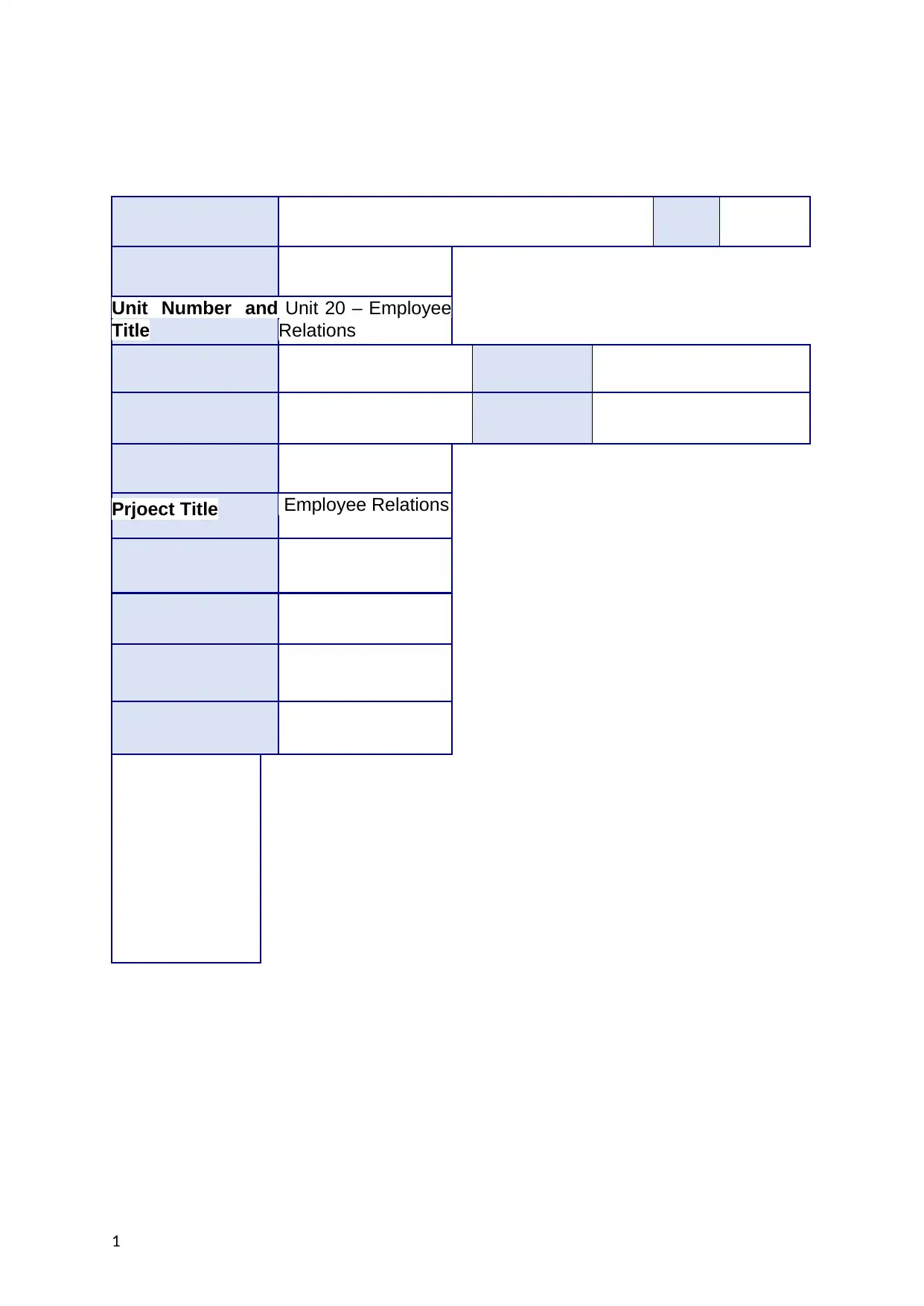
Unit Number and
Title
Unit 20 – Employee
Relations
Prjoect Title Employee Relations
1
Title
Unit 20 – Employee
Relations
Prjoect Title Employee Relations
1
Paraphrase This Document
Need a fresh take? Get an instant paraphrase of this document with our AI Paraphraser
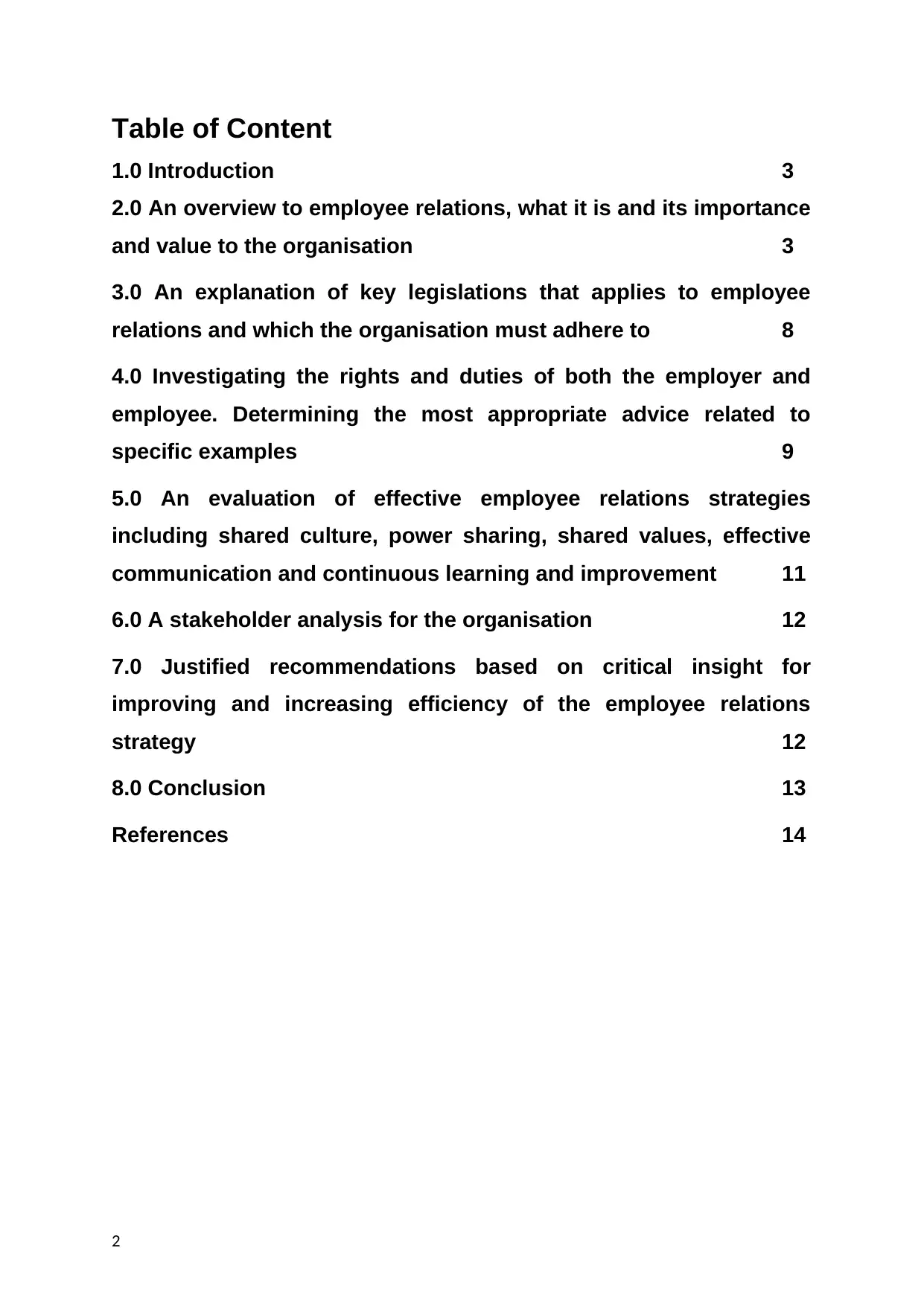
Table of Content
1.0 Introduction 3
2.0 An overview to employee relations, what it is and its importance
and value to the organisation 3
3.0 An explanation of key legislations that applies to employee
relations and which the organisation must adhere to 8
4.0 Investigating the rights and duties of both the employer and
employee. Determining the most appropriate advice related to
specific examples 9
5.0 An evaluation of effective employee relations strategies
including shared culture, power sharing, shared values, effective
communication and continuous learning and improvement 11
6.0 A stakeholder analysis for the organisation 12
7.0 Justified recommendations based on critical insight for
improving and increasing efficiency of the employee relations
strategy 12
8.0 Conclusion 13
References 14
2
1.0 Introduction 3
2.0 An overview to employee relations, what it is and its importance
and value to the organisation 3
3.0 An explanation of key legislations that applies to employee
relations and which the organisation must adhere to 8
4.0 Investigating the rights and duties of both the employer and
employee. Determining the most appropriate advice related to
specific examples 9
5.0 An evaluation of effective employee relations strategies
including shared culture, power sharing, shared values, effective
communication and continuous learning and improvement 11
6.0 A stakeholder analysis for the organisation 12
7.0 Justified recommendations based on critical insight for
improving and increasing efficiency of the employee relations
strategy 12
8.0 Conclusion 13
References 14
2
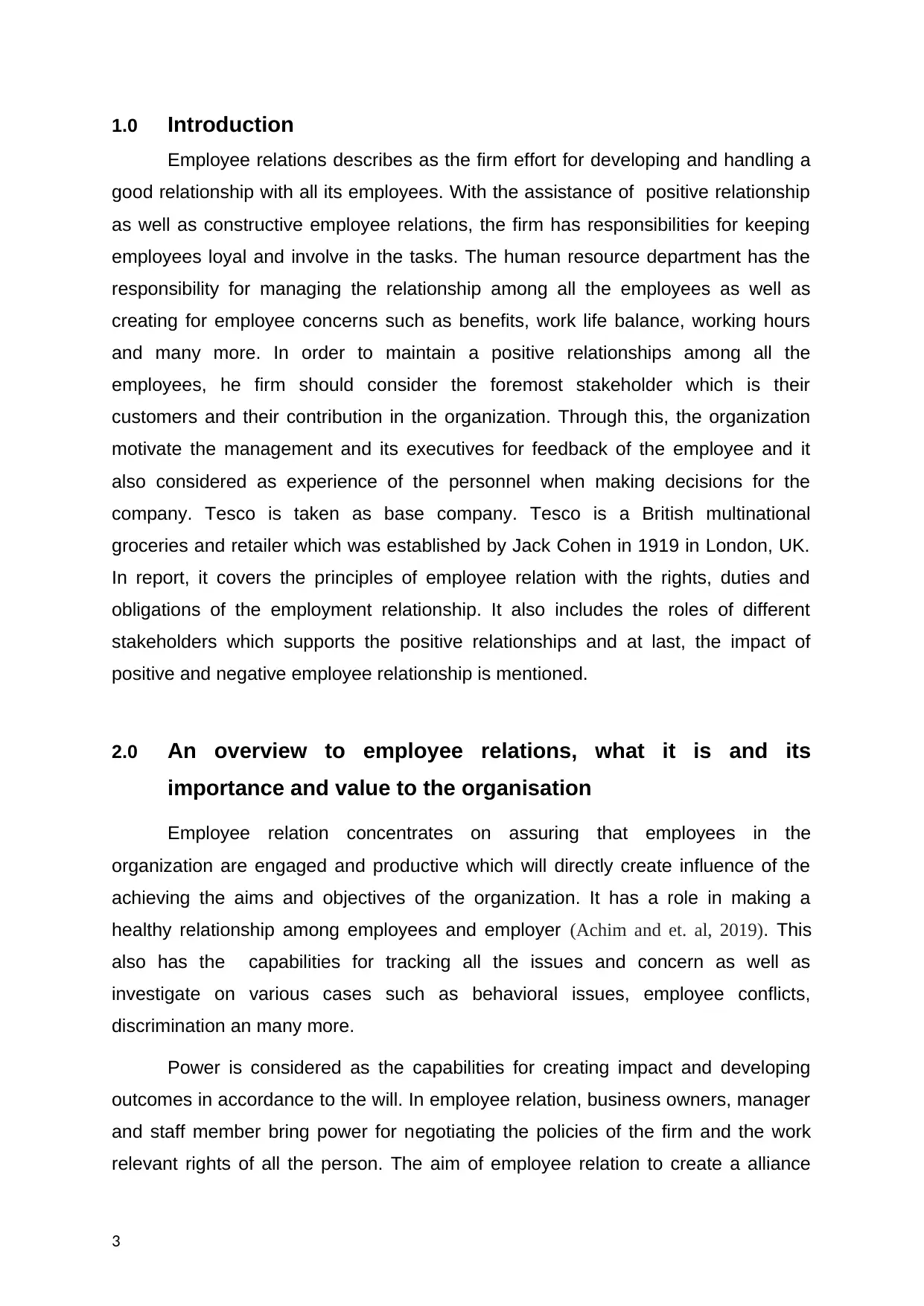
1.0 Introduction
Employee relations describes as the firm effort for developing and handling a
good relationship with all its employees. With the assistance of positive relationship
as well as constructive employee relations, the firm has responsibilities for keeping
employees loyal and involve in the tasks. The human resource department has the
responsibility for managing the relationship among all the employees as well as
creating for employee concerns such as benefits, work life balance, working hours
and many more. In order to maintain a positive relationships among all the
employees, he firm should consider the foremost stakeholder which is their
customers and their contribution in the organization. Through this, the organization
motivate the management and its executives for feedback of the employee and it
also considered as experience of the personnel when making decisions for the
company. Tesco is taken as base company. Tesco is a British multinational
groceries and retailer which was established by Jack Cohen in 1919 in London, UK.
In report, it covers the principles of employee relation with the rights, duties and
obligations of the employment relationship. It also includes the roles of different
stakeholders which supports the positive relationships and at last, the impact of
positive and negative employee relationship is mentioned.
2.0 An overview to employee relations, what it is and its
importance and value to the organisation
Employee relation concentrates on assuring that employees in the
organization are engaged and productive which will directly create influence of the
achieving the aims and objectives of the organization. It has a role in making a
healthy relationship among employees and employer (Achim and et. al, 2019). This
also has the capabilities for tracking all the issues and concern as well as
investigate on various cases such as behavioral issues, employee conflicts,
discrimination an many more.
Power is considered as the capabilities for creating impact and developing
outcomes in accordance to the will. In employee relation, business owners, manager
and staff member bring power for negotiating the policies of the firm and the work
relevant rights of all the person. The aim of employee relation to create a alliance
3
Employee relations describes as the firm effort for developing and handling a
good relationship with all its employees. With the assistance of positive relationship
as well as constructive employee relations, the firm has responsibilities for keeping
employees loyal and involve in the tasks. The human resource department has the
responsibility for managing the relationship among all the employees as well as
creating for employee concerns such as benefits, work life balance, working hours
and many more. In order to maintain a positive relationships among all the
employees, he firm should consider the foremost stakeholder which is their
customers and their contribution in the organization. Through this, the organization
motivate the management and its executives for feedback of the employee and it
also considered as experience of the personnel when making decisions for the
company. Tesco is taken as base company. Tesco is a British multinational
groceries and retailer which was established by Jack Cohen in 1919 in London, UK.
In report, it covers the principles of employee relation with the rights, duties and
obligations of the employment relationship. It also includes the roles of different
stakeholders which supports the positive relationships and at last, the impact of
positive and negative employee relationship is mentioned.
2.0 An overview to employee relations, what it is and its
importance and value to the organisation
Employee relation concentrates on assuring that employees in the
organization are engaged and productive which will directly create influence of the
achieving the aims and objectives of the organization. It has a role in making a
healthy relationship among employees and employer (Achim and et. al, 2019). This
also has the capabilities for tracking all the issues and concern as well as
investigate on various cases such as behavioral issues, employee conflicts,
discrimination an many more.
Power is considered as the capabilities for creating impact and developing
outcomes in accordance to the will. In employee relation, business owners, manager
and staff member bring power for negotiating the policies of the firm and the work
relevant rights of all the person. The aim of employee relation to create a alliance
3
⊘ This is a preview!⊘
Do you want full access?
Subscribe today to unlock all pages.

Trusted by 1+ million students worldwide
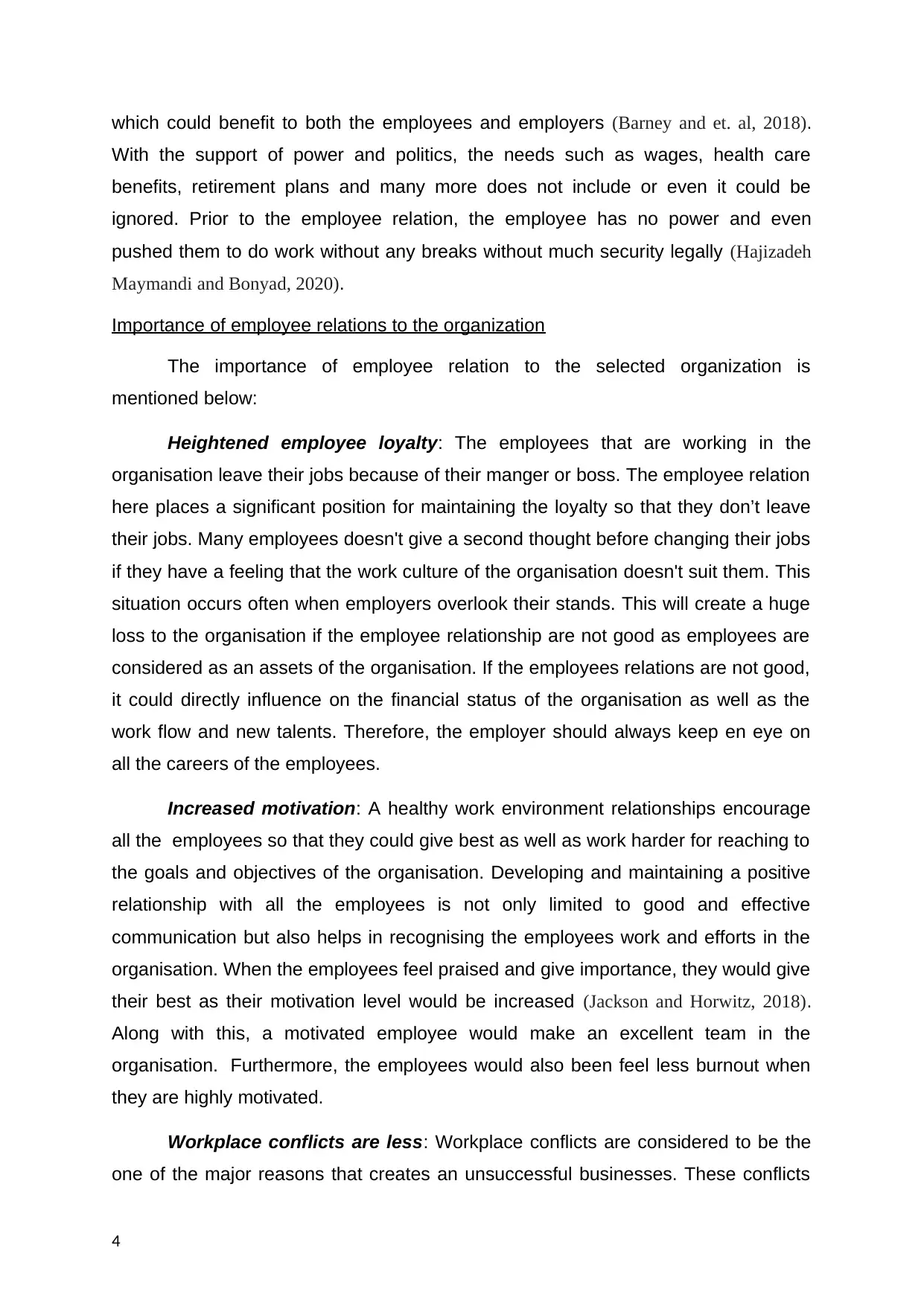
which could benefit to both the employees and employers (Barney and et. al, 2018).
With the support of power and politics, the needs such as wages, health care
benefits, retirement plans and many more does not include or even it could be
ignored. Prior to the employee relation, the employee has no power and even
pushed them to do work without any breaks without much security legally (Hajizadeh
Maymandi and Bonyad, 2020).
Importance of employee relations to the organization
The importance of employee relation to the selected organization is
mentioned below:
Heightened employee loyalty: The employees that are working in the
organisation leave their jobs because of their manger or boss. The employee relation
here places a significant position for maintaining the loyalty so that they don’t leave
their jobs. Many employees doesn't give a second thought before changing their jobs
if they have a feeling that the work culture of the organisation doesn't suit them. This
situation occurs often when employers overlook their stands. This will create a huge
loss to the organisation if the employee relationship are not good as employees are
considered as an assets of the organisation. If the employees relations are not good,
it could directly influence on the financial status of the organisation as well as the
work flow and new talents. Therefore, the employer should always keep en eye on
all the careers of the employees.
Increased motivation: A healthy work environment relationships encourage
all the employees so that they could give best as well as work harder for reaching to
the goals and objectives of the organisation. Developing and maintaining a positive
relationship with all the employees is not only limited to good and effective
communication but also helps in recognising the employees work and efforts in the
organisation. When the employees feel praised and give importance, they would give
their best as their motivation level would be increased (Jackson and Horwitz, 2018).
Along with this, a motivated employee would make an excellent team in the
organisation. Furthermore, the employees would also been feel less burnout when
they are highly motivated.
Workplace conflicts are less: Workplace conflicts are considered to be the
one of the major reasons that creates an unsuccessful businesses. These conflicts
4
With the support of power and politics, the needs such as wages, health care
benefits, retirement plans and many more does not include or even it could be
ignored. Prior to the employee relation, the employee has no power and even
pushed them to do work without any breaks without much security legally (Hajizadeh
Maymandi and Bonyad, 2020).
Importance of employee relations to the organization
The importance of employee relation to the selected organization is
mentioned below:
Heightened employee loyalty: The employees that are working in the
organisation leave their jobs because of their manger or boss. The employee relation
here places a significant position for maintaining the loyalty so that they don’t leave
their jobs. Many employees doesn't give a second thought before changing their jobs
if they have a feeling that the work culture of the organisation doesn't suit them. This
situation occurs often when employers overlook their stands. This will create a huge
loss to the organisation if the employee relationship are not good as employees are
considered as an assets of the organisation. If the employees relations are not good,
it could directly influence on the financial status of the organisation as well as the
work flow and new talents. Therefore, the employer should always keep en eye on
all the careers of the employees.
Increased motivation: A healthy work environment relationships encourage
all the employees so that they could give best as well as work harder for reaching to
the goals and objectives of the organisation. Developing and maintaining a positive
relationship with all the employees is not only limited to good and effective
communication but also helps in recognising the employees work and efforts in the
organisation. When the employees feel praised and give importance, they would give
their best as their motivation level would be increased (Jackson and Horwitz, 2018).
Along with this, a motivated employee would make an excellent team in the
organisation. Furthermore, the employees would also been feel less burnout when
they are highly motivated.
Workplace conflicts are less: Workplace conflicts are considered to be the
one of the major reasons that creates an unsuccessful businesses. These conflicts
4
Paraphrase This Document
Need a fresh take? Get an instant paraphrase of this document with our AI Paraphraser
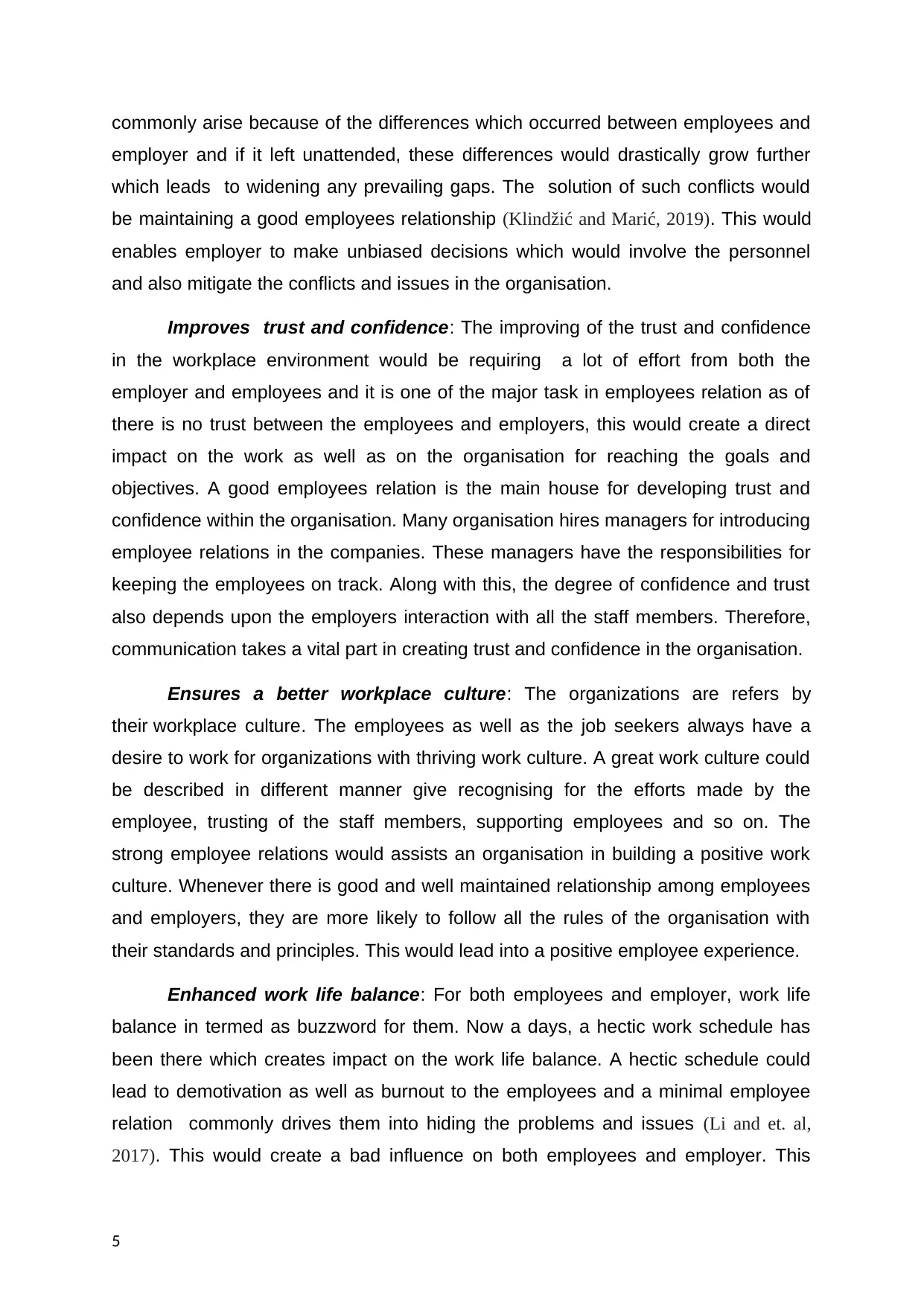
commonly arise because of the differences which occurred between employees and
employer and if it left unattended, these differences would drastically grow further
which leads to widening any prevailing gaps. The solution of such conflicts would
be maintaining a good employees relationship (Klindžić and Marić, 2019). This would
enables employer to make unbiased decisions which would involve the personnel
and also mitigate the conflicts and issues in the organisation.
Improves trust and confidence: The improving of the trust and confidence
in the workplace environment would be requiring a lot of effort from both the
employer and employees and it is one of the major task in employees relation as of
there is no trust between the employees and employers, this would create a direct
impact on the work as well as on the organisation for reaching the goals and
objectives. A good employees relation is the main house for developing trust and
confidence within the organisation. Many organisation hires managers for introducing
employee relations in the companies. These managers have the responsibilities for
keeping the employees on track. Along with this, the degree of confidence and trust
also depends upon the employers interaction with all the staff members. Therefore,
communication takes a vital part in creating trust and confidence in the organisation.
Ensures a better workplace culture: The organizations are refers by
their workplace culture. The employees as well as the job seekers always have a
desire to work for organizations with thriving work culture. A great work culture could
be described in different manner give recognising for the efforts made by the
employee, trusting of the staff members, supporting employees and so on. The
strong employee relations would assists an organisation in building a positive work
culture. Whenever there is good and well maintained relationship among employees
and employers, they are more likely to follow all the rules of the organisation with
their standards and principles. This would lead into a positive employee experience.
Enhanced work life balance: For both employees and employer, work life
balance in termed as buzzword for them. Now a days, a hectic work schedule has
been there which creates impact on the work life balance. A hectic schedule could
lead to demotivation as well as burnout to the employees and a minimal employee
relation commonly drives them into hiding the problems and issues (Li and et. al,
2017). This would create a bad influence on both employees and employer. This
5
employer and if it left unattended, these differences would drastically grow further
which leads to widening any prevailing gaps. The solution of such conflicts would
be maintaining a good employees relationship (Klindžić and Marić, 2019). This would
enables employer to make unbiased decisions which would involve the personnel
and also mitigate the conflicts and issues in the organisation.
Improves trust and confidence: The improving of the trust and confidence
in the workplace environment would be requiring a lot of effort from both the
employer and employees and it is one of the major task in employees relation as of
there is no trust between the employees and employers, this would create a direct
impact on the work as well as on the organisation for reaching the goals and
objectives. A good employees relation is the main house for developing trust and
confidence within the organisation. Many organisation hires managers for introducing
employee relations in the companies. These managers have the responsibilities for
keeping the employees on track. Along with this, the degree of confidence and trust
also depends upon the employers interaction with all the staff members. Therefore,
communication takes a vital part in creating trust and confidence in the organisation.
Ensures a better workplace culture: The organizations are refers by
their workplace culture. The employees as well as the job seekers always have a
desire to work for organizations with thriving work culture. A great work culture could
be described in different manner give recognising for the efforts made by the
employee, trusting of the staff members, supporting employees and so on. The
strong employee relations would assists an organisation in building a positive work
culture. Whenever there is good and well maintained relationship among employees
and employers, they are more likely to follow all the rules of the organisation with
their standards and principles. This would lead into a positive employee experience.
Enhanced work life balance: For both employees and employer, work life
balance in termed as buzzword for them. Now a days, a hectic work schedule has
been there which creates impact on the work life balance. A hectic schedule could
lead to demotivation as well as burnout to the employees and a minimal employee
relation commonly drives them into hiding the problems and issues (Li and et. al,
2017). This would create a bad influence on both employees and employer. This
5
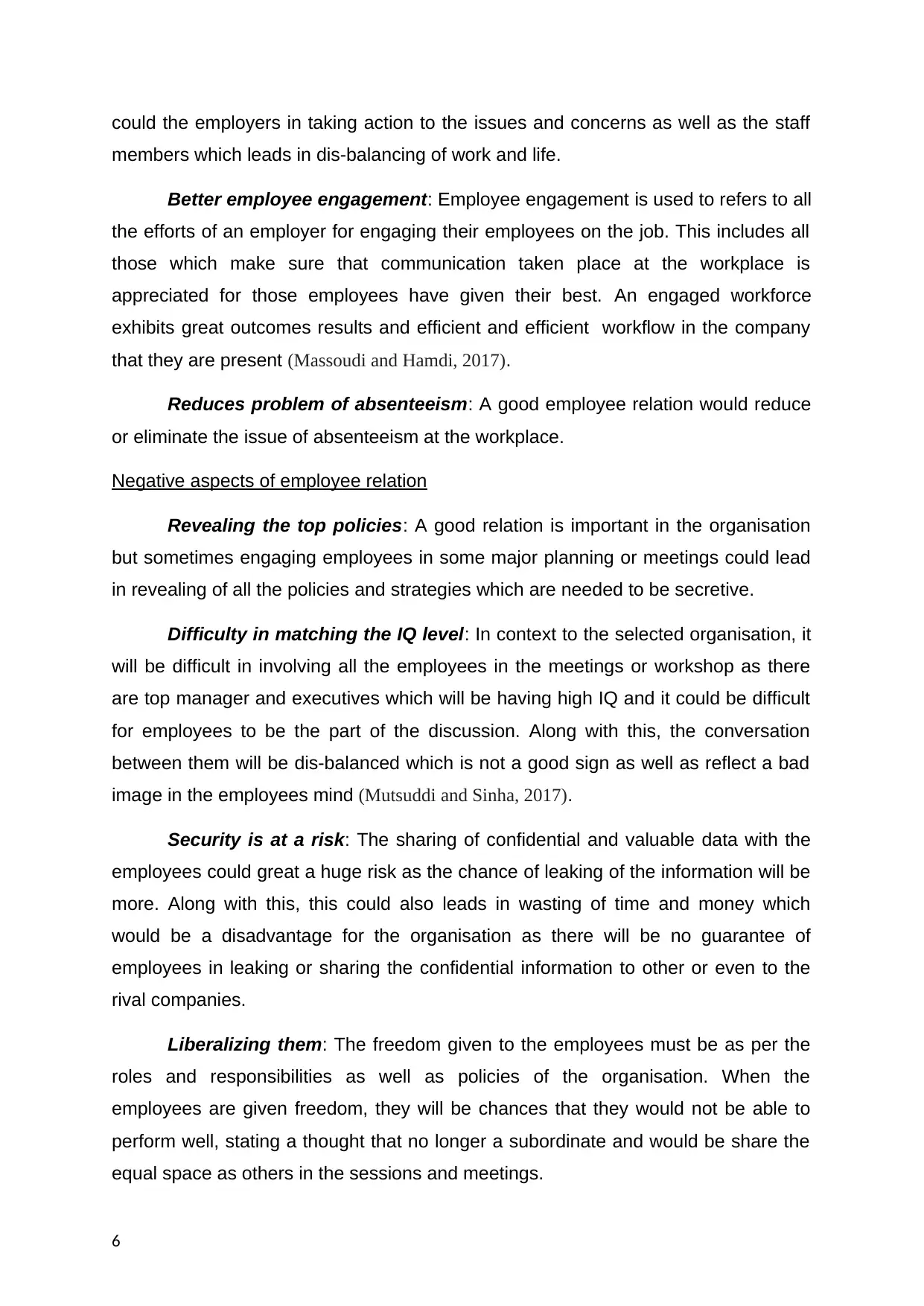
could the employers in taking action to the issues and concerns as well as the staff
members which leads in dis-balancing of work and life.
Better employee engagement: Employee engagement is used to refers to all
the efforts of an employer for engaging their employees on the job. This includes all
those which make sure that communication taken place at the workplace is
appreciated for those employees have given their best. An engaged workforce
exhibits great outcomes results and efficient and efficient workflow in the company
that they are present (Massoudi and Hamdi, 2017).
Reduces problem of absenteeism: A good employee relation would reduce
or eliminate the issue of absenteeism at the workplace.
Negative aspects of employee relation
Revealing the top policies: A good relation is important in the organisation
but sometimes engaging employees in some major planning or meetings could lead
in revealing of all the policies and strategies which are needed to be secretive.
Difficulty in matching the IQ level: In context to the selected organisation, it
will be difficult in involving all the employees in the meetings or workshop as there
are top manager and executives which will be having high IQ and it could be difficult
for employees to be the part of the discussion. Along with this, the conversation
between them will be dis-balanced which is not a good sign as well as reflect a bad
image in the employees mind (Mutsuddi and Sinha, 2017).
Security is at a risk: The sharing of confidential and valuable data with the
employees could great a huge risk as the chance of leaking of the information will be
more. Along with this, this could also leads in wasting of time and money which
would be a disadvantage for the organisation as there will be no guarantee of
employees in leaking or sharing the confidential information to other or even to the
rival companies.
Liberalizing them: The freedom given to the employees must be as per the
roles and responsibilities as well as policies of the organisation. When the
employees are given freedom, they will be chances that they would not be able to
perform well, stating a thought that no longer a subordinate and would be share the
equal space as others in the sessions and meetings.
6
members which leads in dis-balancing of work and life.
Better employee engagement: Employee engagement is used to refers to all
the efforts of an employer for engaging their employees on the job. This includes all
those which make sure that communication taken place at the workplace is
appreciated for those employees have given their best. An engaged workforce
exhibits great outcomes results and efficient and efficient workflow in the company
that they are present (Massoudi and Hamdi, 2017).
Reduces problem of absenteeism: A good employee relation would reduce
or eliminate the issue of absenteeism at the workplace.
Negative aspects of employee relation
Revealing the top policies: A good relation is important in the organisation
but sometimes engaging employees in some major planning or meetings could lead
in revealing of all the policies and strategies which are needed to be secretive.
Difficulty in matching the IQ level: In context to the selected organisation, it
will be difficult in involving all the employees in the meetings or workshop as there
are top manager and executives which will be having high IQ and it could be difficult
for employees to be the part of the discussion. Along with this, the conversation
between them will be dis-balanced which is not a good sign as well as reflect a bad
image in the employees mind (Mutsuddi and Sinha, 2017).
Security is at a risk: The sharing of confidential and valuable data with the
employees could great a huge risk as the chance of leaking of the information will be
more. Along with this, this could also leads in wasting of time and money which
would be a disadvantage for the organisation as there will be no guarantee of
employees in leaking or sharing the confidential information to other or even to the
rival companies.
Liberalizing them: The freedom given to the employees must be as per the
roles and responsibilities as well as policies of the organisation. When the
employees are given freedom, they will be chances that they would not be able to
perform well, stating a thought that no longer a subordinate and would be share the
equal space as others in the sessions and meetings.
6
⊘ This is a preview!⊘
Do you want full access?
Subscribe today to unlock all pages.

Trusted by 1+ million students worldwide
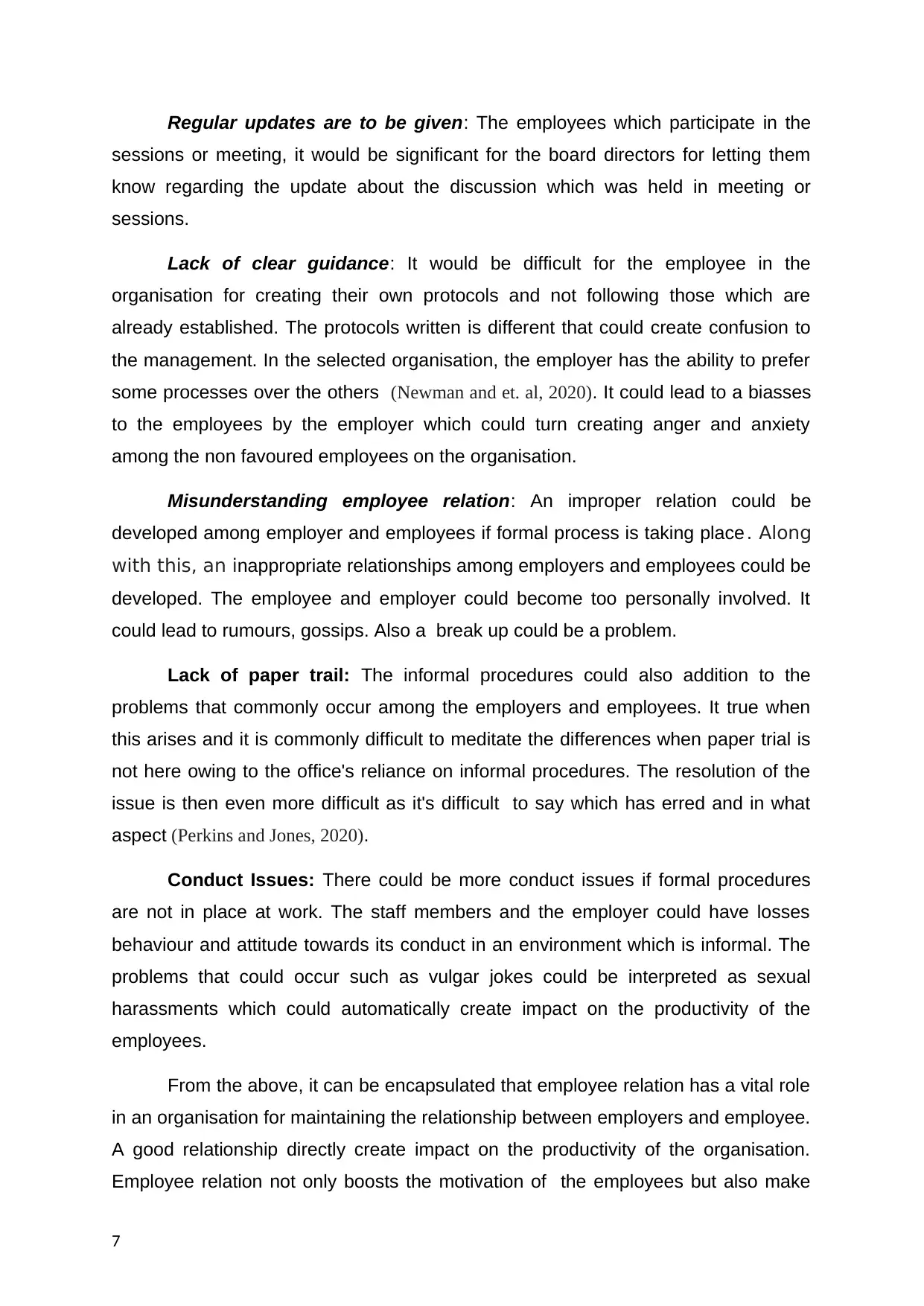
Regular updates are to be given: The employees which participate in the
sessions or meeting, it would be significant for the board directors for letting them
know regarding the update about the discussion which was held in meeting or
sessions.
Lack of clear guidance: It would be difficult for the employee in the
organisation for creating their own protocols and not following those which are
already established. The protocols written is different that could create confusion to
the management. In the selected organisation, the employer has the ability to prefer
some processes over the others (Newman and et. al, 2020). It could lead to a biasses
to the employees by the employer which could turn creating anger and anxiety
among the non favoured employees on the organisation.
Misunderstanding employee relation: An improper relation could be
developed among employer and employees if formal process is taking place. Along
with this, an inappropriate relationships among employers and employees could be
developed. The employee and employer could become too personally involved. It
could lead to rumours, gossips. Also a break up could be a problem.
Lack of paper trail: The informal procedures could also addition to the
problems that commonly occur among the employers and employees. It true when
this arises and it is commonly difficult to meditate the differences when paper trial is
not here owing to the office's reliance on informal procedures. The resolution of the
issue is then even more difficult as it's difficult to say which has erred and in what
aspect (Perkins and Jones, 2020).
Conduct Issues: There could be more conduct issues if formal procedures
are not in place at work. The staff members and the employer could have losses
behaviour and attitude towards its conduct in an environment which is informal. The
problems that could occur such as vulgar jokes could be interpreted as sexual
harassments which could automatically create impact on the productivity of the
employees.
From the above, it can be encapsulated that employee relation has a vital role
in an organisation for maintaining the relationship between employers and employee.
A good relationship directly create impact on the productivity of the organisation.
Employee relation not only boosts the motivation of the employees but also make
7
sessions or meeting, it would be significant for the board directors for letting them
know regarding the update about the discussion which was held in meeting or
sessions.
Lack of clear guidance: It would be difficult for the employee in the
organisation for creating their own protocols and not following those which are
already established. The protocols written is different that could create confusion to
the management. In the selected organisation, the employer has the ability to prefer
some processes over the others (Newman and et. al, 2020). It could lead to a biasses
to the employees by the employer which could turn creating anger and anxiety
among the non favoured employees on the organisation.
Misunderstanding employee relation: An improper relation could be
developed among employer and employees if formal process is taking place. Along
with this, an inappropriate relationships among employers and employees could be
developed. The employee and employer could become too personally involved. It
could lead to rumours, gossips. Also a break up could be a problem.
Lack of paper trail: The informal procedures could also addition to the
problems that commonly occur among the employers and employees. It true when
this arises and it is commonly difficult to meditate the differences when paper trial is
not here owing to the office's reliance on informal procedures. The resolution of the
issue is then even more difficult as it's difficult to say which has erred and in what
aspect (Perkins and Jones, 2020).
Conduct Issues: There could be more conduct issues if formal procedures
are not in place at work. The staff members and the employer could have losses
behaviour and attitude towards its conduct in an environment which is informal. The
problems that could occur such as vulgar jokes could be interpreted as sexual
harassments which could automatically create impact on the productivity of the
employees.
From the above, it can be encapsulated that employee relation has a vital role
in an organisation for maintaining the relationship between employers and employee.
A good relationship directly create impact on the productivity of the organisation.
Employee relation not only boosts the motivation of the employees but also make
7
Paraphrase This Document
Need a fresh take? Get an instant paraphrase of this document with our AI Paraphraser
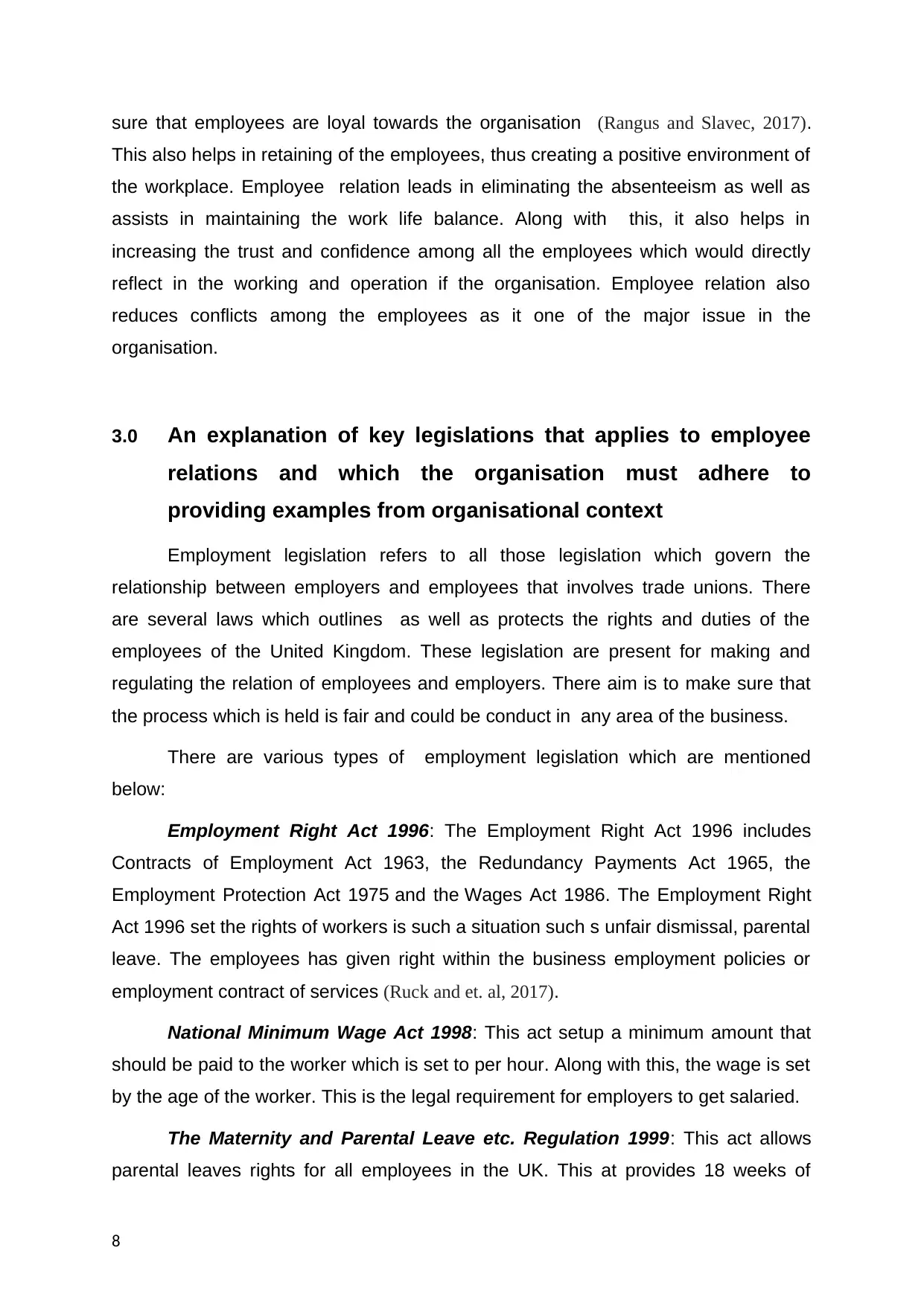
sure that employees are loyal towards the organisation (Rangus and Slavec, 2017).
This also helps in retaining of the employees, thus creating a positive environment of
the workplace. Employee relation leads in eliminating the absenteeism as well as
assists in maintaining the work life balance. Along with this, it also helps in
increasing the trust and confidence among all the employees which would directly
reflect in the working and operation if the organisation. Employee relation also
reduces conflicts among the employees as it one of the major issue in the
organisation.
3.0 An explanation of key legislations that applies to employee
relations and which the organisation must adhere to
providing examples from organisational context
Employment legislation refers to all those legislation which govern the
relationship between employers and employees that involves trade unions. There
are several laws which outlines as well as protects the rights and duties of the
employees of the United Kingdom. These legislation are present for making and
regulating the relation of employees and employers. There aim is to make sure that
the process which is held is fair and could be conduct in any area of the business.
There are various types of employment legislation which are mentioned
below:
Employment Right Act 1996: The Employment Right Act 1996 includes
Contracts of Employment Act 1963, the Redundancy Payments Act 1965, the
Employment Protection Act 1975 and the Wages Act 1986. The Employment Right
Act 1996 set the rights of workers is such a situation such s unfair dismissal, parental
leave. The employees has given right within the business employment policies or
employment contract of services (Ruck and et. al, 2017).
National Minimum Wage Act 1998: This act setup a minimum amount that
should be paid to the worker which is set to per hour. Along with this, the wage is set
by the age of the worker. This is the legal requirement for employers to get salaried.
The Maternity and Parental Leave etc. Regulation 1999: This act allows
parental leaves rights for all employees in the UK. This at provides 18 weeks of
8
This also helps in retaining of the employees, thus creating a positive environment of
the workplace. Employee relation leads in eliminating the absenteeism as well as
assists in maintaining the work life balance. Along with this, it also helps in
increasing the trust and confidence among all the employees which would directly
reflect in the working and operation if the organisation. Employee relation also
reduces conflicts among the employees as it one of the major issue in the
organisation.
3.0 An explanation of key legislations that applies to employee
relations and which the organisation must adhere to
providing examples from organisational context
Employment legislation refers to all those legislation which govern the
relationship between employers and employees that involves trade unions. There
are several laws which outlines as well as protects the rights and duties of the
employees of the United Kingdom. These legislation are present for making and
regulating the relation of employees and employers. There aim is to make sure that
the process which is held is fair and could be conduct in any area of the business.
There are various types of employment legislation which are mentioned
below:
Employment Right Act 1996: The Employment Right Act 1996 includes
Contracts of Employment Act 1963, the Redundancy Payments Act 1965, the
Employment Protection Act 1975 and the Wages Act 1986. The Employment Right
Act 1996 set the rights of workers is such a situation such s unfair dismissal, parental
leave. The employees has given right within the business employment policies or
employment contract of services (Ruck and et. al, 2017).
National Minimum Wage Act 1998: This act setup a minimum amount that
should be paid to the worker which is set to per hour. Along with this, the wage is set
by the age of the worker. This is the legal requirement for employers to get salaried.
The Maternity and Parental Leave etc. Regulation 1999: This act allows
parental leaves rights for all employees in the UK. This at provides 18 weeks of
8
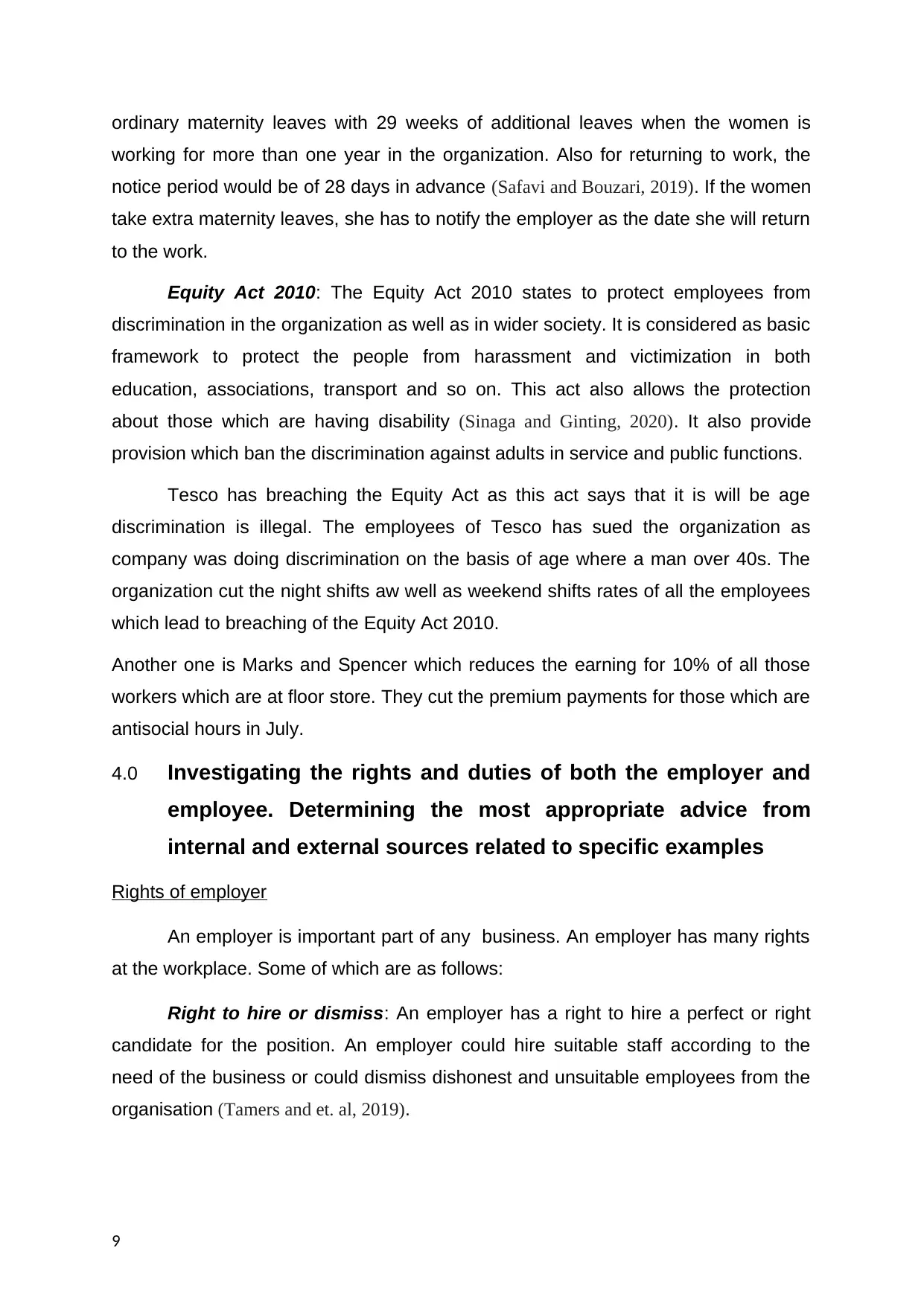
ordinary maternity leaves with 29 weeks of additional leaves when the women is
working for more than one year in the organization. Also for returning to work, the
notice period would be of 28 days in advance (Safavi and Bouzari, 2019). If the women
take extra maternity leaves, she has to notify the employer as the date she will return
to the work.
Equity Act 2010: The Equity Act 2010 states to protect employees from
discrimination in the organization as well as in wider society. It is considered as basic
framework to protect the people from harassment and victimization in both
education, associations, transport and so on. This act also allows the protection
about those which are having disability (Sinaga and Ginting, 2020). It also provide
provision which ban the discrimination against adults in service and public functions.
Tesco has breaching the Equity Act as this act says that it is will be age
discrimination is illegal. The employees of Tesco has sued the organization as
company was doing discrimination on the basis of age where a man over 40s. The
organization cut the night shifts aw well as weekend shifts rates of all the employees
which lead to breaching of the Equity Act 2010.
Another one is Marks and Spencer which reduces the earning for 10% of all those
workers which are at floor store. They cut the premium payments for those which are
antisocial hours in July.
4.0 Investigating the rights and duties of both the employer and
employee. Determining the most appropriate advice from
internal and external sources related to specific examples
Rights of employer
An employer is important part of any business. An employer has many rights
at the workplace. Some of which are as follows:
Right to hire or dismiss: An employer has a right to hire a perfect or right
candidate for the position. An employer could hire suitable staff according to the
need of the business or could dismiss dishonest and unsuitable employees from the
organisation (Tamers and et. al, 2019).
9
working for more than one year in the organization. Also for returning to work, the
notice period would be of 28 days in advance (Safavi and Bouzari, 2019). If the women
take extra maternity leaves, she has to notify the employer as the date she will return
to the work.
Equity Act 2010: The Equity Act 2010 states to protect employees from
discrimination in the organization as well as in wider society. It is considered as basic
framework to protect the people from harassment and victimization in both
education, associations, transport and so on. This act also allows the protection
about those which are having disability (Sinaga and Ginting, 2020). It also provide
provision which ban the discrimination against adults in service and public functions.
Tesco has breaching the Equity Act as this act says that it is will be age
discrimination is illegal. The employees of Tesco has sued the organization as
company was doing discrimination on the basis of age where a man over 40s. The
organization cut the night shifts aw well as weekend shifts rates of all the employees
which lead to breaching of the Equity Act 2010.
Another one is Marks and Spencer which reduces the earning for 10% of all those
workers which are at floor store. They cut the premium payments for those which are
antisocial hours in July.
4.0 Investigating the rights and duties of both the employer and
employee. Determining the most appropriate advice from
internal and external sources related to specific examples
Rights of employer
An employer is important part of any business. An employer has many rights
at the workplace. Some of which are as follows:
Right to hire or dismiss: An employer has a right to hire a perfect or right
candidate for the position. An employer could hire suitable staff according to the
need of the business or could dismiss dishonest and unsuitable employees from the
organisation (Tamers and et. al, 2019).
9
⊘ This is a preview!⊘
Do you want full access?
Subscribe today to unlock all pages.

Trusted by 1+ million students worldwide
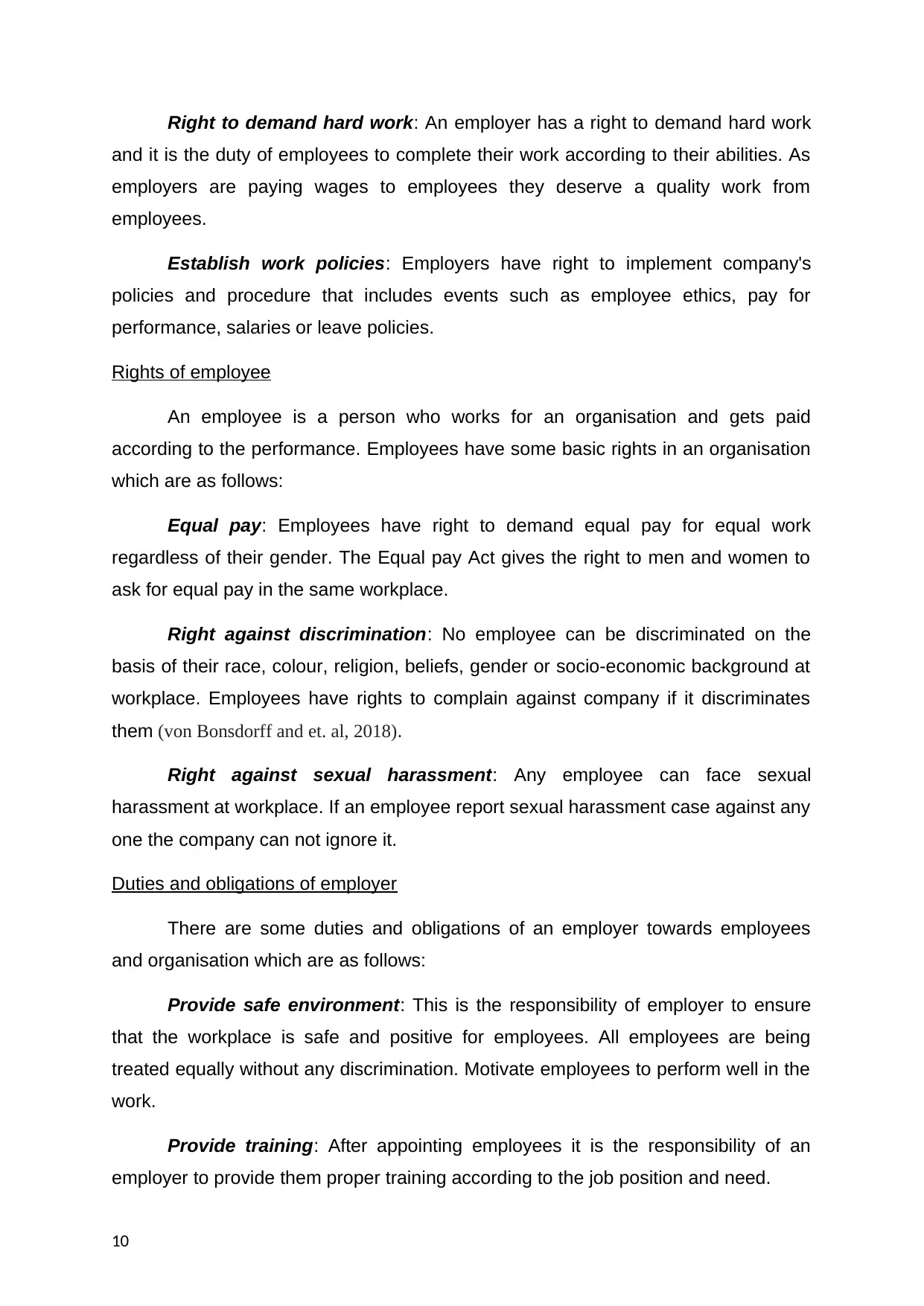
Right to demand hard work: An employer has a right to demand hard work
and it is the duty of employees to complete their work according to their abilities. As
employers are paying wages to employees they deserve a quality work from
employees.
Establish work policies: Employers have right to implement company's
policies and procedure that includes events such as employee ethics, pay for
performance, salaries or leave policies.
Rights of employee
An employee is a person who works for an organisation and gets paid
according to the performance. Employees have some basic rights in an organisation
which are as follows:
Equal pay: Employees have right to demand equal pay for equal work
regardless of their gender. The Equal pay Act gives the right to men and women to
ask for equal pay in the same workplace.
Right against discrimination: No employee can be discriminated on the
basis of their race, colour, religion, beliefs, gender or socio-economic background at
workplace. Employees have rights to complain against company if it discriminates
them (von Bonsdorff and et. al, 2018).
Right against sexual harassment: Any employee can face sexual
harassment at workplace. If an employee report sexual harassment case against any
one the company can not ignore it.
Duties and obligations of employer
There are some duties and obligations of an employer towards employees
and organisation which are as follows:
Provide safe environment: This is the responsibility of employer to ensure
that the workplace is safe and positive for employees. All employees are being
treated equally without any discrimination. Motivate employees to perform well in the
work.
Provide training: After appointing employees it is the responsibility of an
employer to provide them proper training according to the job position and need.
10
and it is the duty of employees to complete their work according to their abilities. As
employers are paying wages to employees they deserve a quality work from
employees.
Establish work policies: Employers have right to implement company's
policies and procedure that includes events such as employee ethics, pay for
performance, salaries or leave policies.
Rights of employee
An employee is a person who works for an organisation and gets paid
according to the performance. Employees have some basic rights in an organisation
which are as follows:
Equal pay: Employees have right to demand equal pay for equal work
regardless of their gender. The Equal pay Act gives the right to men and women to
ask for equal pay in the same workplace.
Right against discrimination: No employee can be discriminated on the
basis of their race, colour, religion, beliefs, gender or socio-economic background at
workplace. Employees have rights to complain against company if it discriminates
them (von Bonsdorff and et. al, 2018).
Right against sexual harassment: Any employee can face sexual
harassment at workplace. If an employee report sexual harassment case against any
one the company can not ignore it.
Duties and obligations of employer
There are some duties and obligations of an employer towards employees
and organisation which are as follows:
Provide safe environment: This is the responsibility of employer to ensure
that the workplace is safe and positive for employees. All employees are being
treated equally without any discrimination. Motivate employees to perform well in the
work.
Provide training: After appointing employees it is the responsibility of an
employer to provide them proper training according to the job position and need.
10
Paraphrase This Document
Need a fresh take? Get an instant paraphrase of this document with our AI Paraphraser
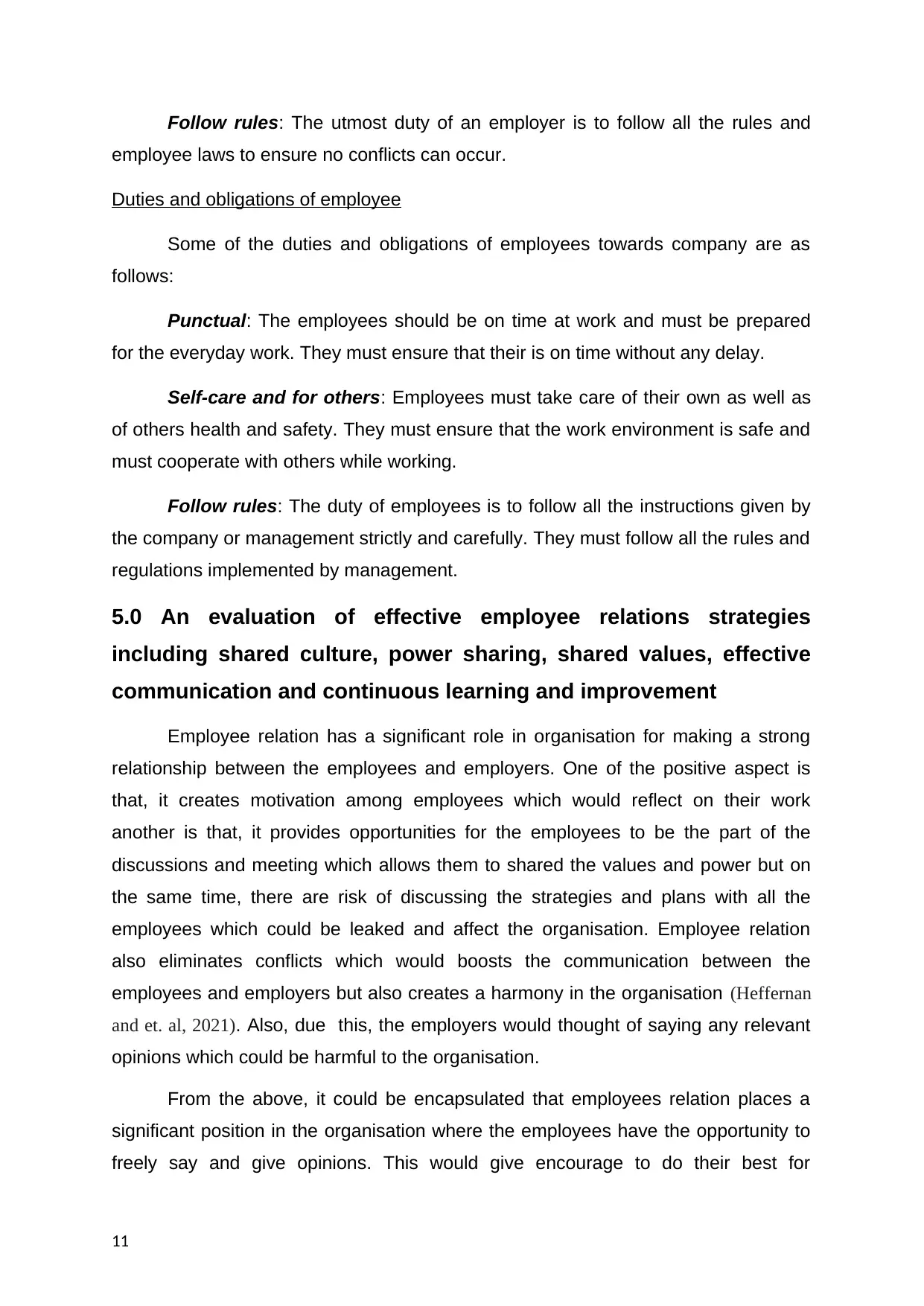
Follow rules: The utmost duty of an employer is to follow all the rules and
employee laws to ensure no conflicts can occur.
Duties and obligations of employee
Some of the duties and obligations of employees towards company are as
follows:
Punctual: The employees should be on time at work and must be prepared
for the everyday work. They must ensure that their is on time without any delay.
Self-care and for others: Employees must take care of their own as well as
of others health and safety. They must ensure that the work environment is safe and
must cooperate with others while working.
Follow rules: The duty of employees is to follow all the instructions given by
the company or management strictly and carefully. They must follow all the rules and
regulations implemented by management.
5.0 An evaluation of effective employee relations strategies
including shared culture, power sharing, shared values, effective
communication and continuous learning and improvement
Employee relation has a significant role in organisation for making a strong
relationship between the employees and employers. One of the positive aspect is
that, it creates motivation among employees which would reflect on their work
another is that, it provides opportunities for the employees to be the part of the
discussions and meeting which allows them to shared the values and power but on
the same time, there are risk of discussing the strategies and plans with all the
employees which could be leaked and affect the organisation. Employee relation
also eliminates conflicts which would boosts the communication between the
employees and employers but also creates a harmony in the organisation (Heffernan
and et. al, 2021). Also, due this, the employers would thought of saying any relevant
opinions which could be harmful to the organisation.
From the above, it could be encapsulated that employees relation places a
significant position in the organisation where the employees have the opportunity to
freely say and give opinions. This would give encourage to do their best for
11
employee laws to ensure no conflicts can occur.
Duties and obligations of employee
Some of the duties and obligations of employees towards company are as
follows:
Punctual: The employees should be on time at work and must be prepared
for the everyday work. They must ensure that their is on time without any delay.
Self-care and for others: Employees must take care of their own as well as
of others health and safety. They must ensure that the work environment is safe and
must cooperate with others while working.
Follow rules: The duty of employees is to follow all the instructions given by
the company or management strictly and carefully. They must follow all the rules and
regulations implemented by management.
5.0 An evaluation of effective employee relations strategies
including shared culture, power sharing, shared values, effective
communication and continuous learning and improvement
Employee relation has a significant role in organisation for making a strong
relationship between the employees and employers. One of the positive aspect is
that, it creates motivation among employees which would reflect on their work
another is that, it provides opportunities for the employees to be the part of the
discussions and meeting which allows them to shared the values and power but on
the same time, there are risk of discussing the strategies and plans with all the
employees which could be leaked and affect the organisation. Employee relation
also eliminates conflicts which would boosts the communication between the
employees and employers but also creates a harmony in the organisation (Heffernan
and et. al, 2021). Also, due this, the employers would thought of saying any relevant
opinions which could be harmful to the organisation.
From the above, it could be encapsulated that employees relation places a
significant position in the organisation where the employees have the opportunity to
freely say and give opinions. This would give encourage to do their best for
11
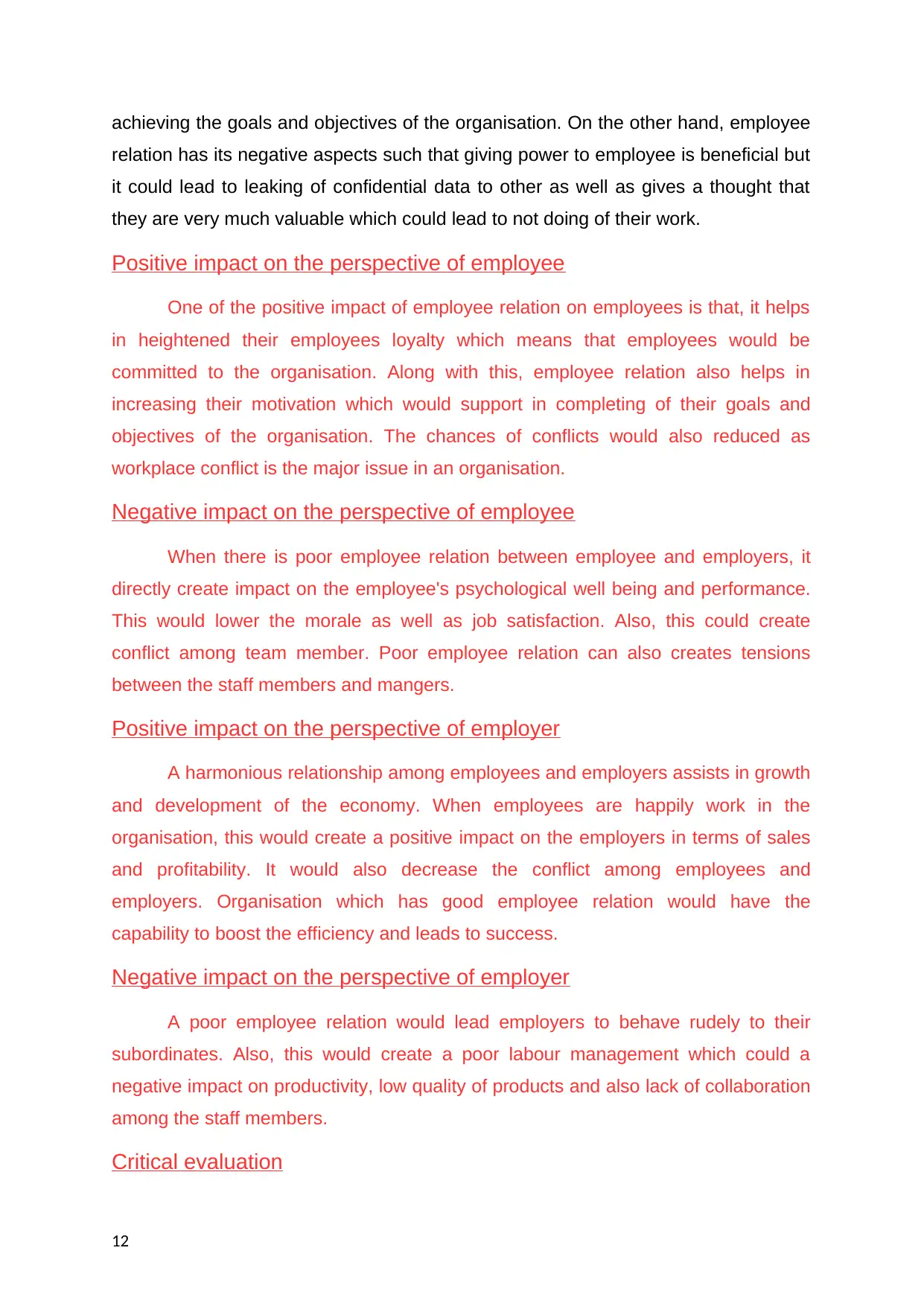
achieving the goals and objectives of the organisation. On the other hand, employee
relation has its negative aspects such that giving power to employee is beneficial but
it could lead to leaking of confidential data to other as well as gives a thought that
they are very much valuable which could lead to not doing of their work.
Positive impact on the perspective of employee
One of the positive impact of employee relation on employees is that, it helps
in heightened their employees loyalty which means that employees would be
committed to the organisation. Along with this, employee relation also helps in
increasing their motivation which would support in completing of their goals and
objectives of the organisation. The chances of conflicts would also reduced as
workplace conflict is the major issue in an organisation.
Negative impact on the perspective of employee
When there is poor employee relation between employee and employers, it
directly create impact on the employee's psychological well being and performance.
This would lower the morale as well as job satisfaction. Also, this could create
conflict among team member. Poor employee relation can also creates tensions
between the staff members and mangers.
Positive impact on the perspective of employer
A harmonious relationship among employees and employers assists in growth
and development of the economy. When employees are happily work in the
organisation, this would create a positive impact on the employers in terms of sales
and profitability. It would also decrease the conflict among employees and
employers. Organisation which has good employee relation would have the
capability to boost the efficiency and leads to success.
Negative impact on the perspective of employer
A poor employee relation would lead employers to behave rudely to their
subordinates. Also, this would create a poor labour management which could a
negative impact on productivity, low quality of products and also lack of collaboration
among the staff members.
Critical evaluation
12
relation has its negative aspects such that giving power to employee is beneficial but
it could lead to leaking of confidential data to other as well as gives a thought that
they are very much valuable which could lead to not doing of their work.
Positive impact on the perspective of employee
One of the positive impact of employee relation on employees is that, it helps
in heightened their employees loyalty which means that employees would be
committed to the organisation. Along with this, employee relation also helps in
increasing their motivation which would support in completing of their goals and
objectives of the organisation. The chances of conflicts would also reduced as
workplace conflict is the major issue in an organisation.
Negative impact on the perspective of employee
When there is poor employee relation between employee and employers, it
directly create impact on the employee's psychological well being and performance.
This would lower the morale as well as job satisfaction. Also, this could create
conflict among team member. Poor employee relation can also creates tensions
between the staff members and mangers.
Positive impact on the perspective of employer
A harmonious relationship among employees and employers assists in growth
and development of the economy. When employees are happily work in the
organisation, this would create a positive impact on the employers in terms of sales
and profitability. It would also decrease the conflict among employees and
employers. Organisation which has good employee relation would have the
capability to boost the efficiency and leads to success.
Negative impact on the perspective of employer
A poor employee relation would lead employers to behave rudely to their
subordinates. Also, this would create a poor labour management which could a
negative impact on productivity, low quality of products and also lack of collaboration
among the staff members.
Critical evaluation
12
⊘ This is a preview!⊘
Do you want full access?
Subscribe today to unlock all pages.

Trusted by 1+ million students worldwide
1 out of 16
Related Documents
Your All-in-One AI-Powered Toolkit for Academic Success.
+13062052269
info@desklib.com
Available 24*7 on WhatsApp / Email
![[object Object]](/_next/static/media/star-bottom.7253800d.svg)
Unlock your academic potential
Copyright © 2020–2025 A2Z Services. All Rights Reserved. Developed and managed by ZUCOL.





